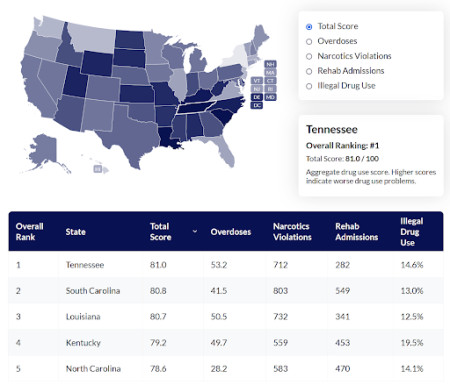Rehab.com Study Finds Southern States Rank Worst in Nation for Drug Abuse & Addiction

NEW YORK, May 28, 2024 (Newswire.com) - Five Southern states rank as the worst in the nation for drug and alcohol addiction, overdoses, deaths, and drug-involved crimes and narcotics violations, according to a new study by Rehab.com.
The new report provides a detailed look at the complex landscape of drug and alcohol use, including the effects of marijuana, cocaine, methamphetamine, heroin and fentanyl.
"All Americans across the U.S., coast to coast, and every community in between have been harmed by fentanyl.”
-Drug Enforcement Administration (DEA) Administrator Anne Milgram
The May report, “Drug Use Statistics in the United States,” aggregates data categories into an overall state ranking. Data comes from the Substance Abuse and Mental Health Services Administration, the Centers for Disease Control and Prevention, the Department of Justice, private treatment centers and hospitals, among other sources.
Tennessee with an aggregate score of 81 out of 100 comes in dead last of the 50 states followed by four other Southern states – South Carolina at 80.8; Louisiana at 80.7; Kentucky at 79.2 and North Carolina at 78.6.
The states with the least problems with drug and alcohol addiction, according to the report, are: New York with an aggregate score of 59.9; Hawaii at 62; Montana at 63.9; New Jersey also at 63.9 and Washington at 64.3.
Cities with the highest per capita rates of drug use are mostly in the Midwest and East Coast, regions where the opioid epidemic continues to rage. The worst cities for drug and alcohol addiction are Milwaukee at 58.8 out of 100; Baltimore at 54; Minneapolis at 52.5; Cleveland at 51.2 and Philadelphia at 49.9.
The cities with the lowest rates of drug and alcohol abuse are in Texas and California:
El Paso at 24.2; San Jose at 26.7; Oakland at 28; San Antonio at 32.1 and Fort Worth at 32.9. (Data categories used to measure cities are different from those for states due to regional data availability.)
Other key findings from the report:
- Demographics:
- Young adults (18-25) have the highest drug and alcohol use and the most drug-related emergency room visits.
- Adults aged 26-34 report the highest instances of binge drinking.
- Border Drug Seizures:
- In December 2023, over 11,000 pounds of methamphetamine, 9,500 pounds of marijuana, and 6,000 pounds of cocaine were confiscated.
- The DEA reports over 376 million lethal doses of fentanyl were seized in 2023, enough to kill every person in the U.S. Just 2 milligrams of fentanyl can be fatal.
- Impact on Specific Populations:
- The LGBTQ+ community is twice as likely to suffer from addiction compared to the general population.
- Veterans are 27% more likely to have a binge drinking problem than the general population.
- Economic Cost:
- In 2023, the average American taxpayer paid $260 to combat the drug epidemic, up from $159 in 2013.
- Homeless Population:
- One-fourth of all deaths among the homeless are attributed to drug overdose. Washington, D.C., has the highest per capita homeless rate and the highest number of overdose-related deaths within this population.
- College Students:
- Nearly 2 million full-time college students reported using an illegal substance in the past month.
- Two out of five college students reported binge drinking (consuming five or more drinks on one occasion).
City and state drug use scores were created with aggregated data from national organizations and government agencies such as the CDC, FBI, SAMHSA, and U.S. Customs and Border Protection.
Aggregated statistics include drug overdose deaths, narcotics violations, number of opioid prescriptions, cost of addiction treatment, border drug seizures and recreational drug and alcohol use.
Each statistic was assigned a weight based on the relative prevalence of the issue (e.g. drug overdoses set to 20 points), and the city or state with the worst rate given full points. Scores for all individual statistics were then added to create a total score out of 100 for all locations. All data were standardized on a per-capita basis to allow for even comparisons among cities and states.
Source: Rehab.com
